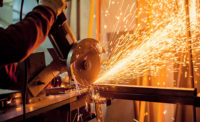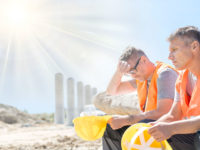Worksite safety plays a big role in refractories, mines, construction worksites and a number of other operations. According to the U.S. Bureau of Labor Statistics, up to 50,000 workers were injured in 2020 when struck by falling debris. Additionally, between 2016 and 2020, there were 1,228 recorded fatalities due to the same safety hazard. Instances that don’t result in major injury or fatality often go unrecorded, which means the true numbers could be – and likely are – much higher.
These statistics are a hard reality and a major motivator for many companies to invest in safety equipment. Along with enhanced training and increased safety procedures, well-designed safety equipment can play a large role in companies’ efforts to protect employees from unnecessary risks. Safety cages are a simple, often overlooked solution that protects workers from falling objects, whether they are working in a kiln, in a mine or on a construction site. But not all safety cages are the same. Here are a few things to consider when looking for a quality safety cage.
Put your trust in quality
The first criterion to consider is the quality of the design and material. Look for a manufacturer that designs its safety cages to meet the most stringent global standards and uses high-quality materials, such as 6061-T6 aircraft-grade aluminum. Well-designed safety cages include an umbrella-type structure to deflect large pieces of coating, rock or debris 360 degrees around the cage. To absorb the initial impact, the roof ribs are designed with “crumple zones,” much like a car, to protect the workers inside.
Another feature to help absorb shock that appears on industry-leading safety cage models is specially engineered legs that contain springs that absorb the remaining impact energy of falling material. The legs are tipped with spikes that dig into the ground to provide extra traction and stability upon impact. To catch smaller debris, well-designed safety cages also feature lightweight stainless steel mesh netting.
However, preventing serious injuries and fatalities is just one part of the safety equation. Ergonomic equipment also prevents physical strain that can cause injury and disability over time. A quality safety cage is constructed from lightweight material that makes it easy for two workers to carry with flip-up handles. A safety cage made from 6061-T6 aircraft-grade aluminum, for example, is just 140 pounds (64 kilograms) – as much as 50 percent lighter than a steel alternative.
Tested and proven
Lightweight material might seem counter intuitive for safety cages; however, experienced safety cage manufacturers put their designs through various impact tests to ensure the material will stand up to the strain. Look for a manufacturer that implements both computer simulations and intensive destructive testing. Some manufacturers even conduct drop tests at 125% the maximum distance that actual conditions would allow. These tests involve using overweight materials dropped on different points of the cage at different angles to test each safety component. This level of research helps the manufacturer determine the maximum mass and velocity that the product can handle. Some safety cages can withstand up to 250 pounds (114 kg) falling from a height of 96 inches (2.44 m).
The real test is how the cage performs on the jobsite. A cement plant in Turkey, for example, had an incident where large amounts of coating fell while two workers were inside the kiln. The workers were using a high-quality safety cage that had been rigorously tested, and it handily withstood a greater load than its rating. The workers survived the collapse and escaped without injury.
Invest in trustworthy equipment
Keeping employees safe is one of the biggest factors of any jobsite, which is why safety is a subject that keeps industry leaders up at night. Something as simple as the addition of a safety cage to a jobsite can result in lives saved. Investing in a safe, quality product is a great way to protect employees against damages and, in the long run, protect companies from everything from fines to high insurance costs. Ultimately, investments in safety equipment are investments in success. Can you afford not to?



